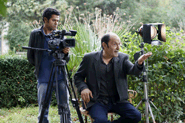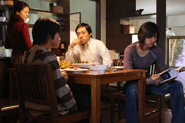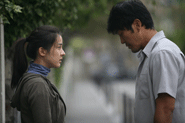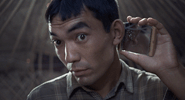 The Headless Woman, 2008. In retrospect, the swooning, haunted enigma of Lucrecia Martel’s latest film is revealed in the metaphoric image of a landscaper digging around in frustration along the perimeter of a garden bed, trying to make room for ornamental trees that the owner, Verónica (María Onetto) had purchased during a recent trip to the nursery. The backyard had once been the site of a water structure (perhaps a pool or fountain) that had since been buried, and the ground is no longer suitable for planting, salvageable only by creating the appearance of planted trees by placing them in large earthen pots along the periphery, to be hidden behind more ornamental shrubs. Like the hidden, seemingly trivial abandoned garden object, a concealment also subtly – but palpably – alters the surface of the landscape in The Headless Woman. Hurrying to a rendezvous with her lover (and family friend), Juan Manuel (Daniel Genoud) in another town, a distracted Verónica, reaching for her cell phone, collides with something on the road – the outline of a dog’s carcass visible on the far edge of the frame – and continues on for a few yards before stopping to compose herself and driving away. But as Verónica returns to the familiar rituals of her daily life – a busy dental practice, a never-ending landscaping project, a supportive, but equally distracted husband named Marcos (César Bordón), a sickly, coddled daughter – the fissures in her empty, privileged existence of cultivated gardens and choreographed white lies begin to surface, manifesting in her increasing apprehension that she has accidentally killed somebody on that desolate road. Martel further hones the visual economy and organic (yet meticulously structured), fractal narrative of her earlier films to create an Antonioniesque portrait of ennui and bourgeois dysfunction (in one insightful sequence, the housekeeper offers to dress a game animal that had been shot by Marcos during a recent hunt, repeating the idea of killing and interceded cleaning). Moreover, Martel’s recurring themes of classism and privilege are elegantly brought to the forefront in The Headless Woman, reflected explicitly in the disposability of a potter’s missing errand boy (who becomes immediately replaceable when his younger brother takes over his job), and implicitly in an impoverished town’s profound disconnection from the nearby, more affluent city (in one episode, Verónica ventures into the missing boy’s neighborhood and the residents are unable to provide directions on how to get out of the slums, illustrating the social – and institutional – reality of their inability to escape their poverty and marginalization).
The Headless Woman, 2008. In retrospect, the swooning, haunted enigma of Lucrecia Martel’s latest film is revealed in the metaphoric image of a landscaper digging around in frustration along the perimeter of a garden bed, trying to make room for ornamental trees that the owner, Verónica (María Onetto) had purchased during a recent trip to the nursery. The backyard had once been the site of a water structure (perhaps a pool or fountain) that had since been buried, and the ground is no longer suitable for planting, salvageable only by creating the appearance of planted trees by placing them in large earthen pots along the periphery, to be hidden behind more ornamental shrubs. Like the hidden, seemingly trivial abandoned garden object, a concealment also subtly – but palpably – alters the surface of the landscape in The Headless Woman. Hurrying to a rendezvous with her lover (and family friend), Juan Manuel (Daniel Genoud) in another town, a distracted Verónica, reaching for her cell phone, collides with something on the road – the outline of a dog’s carcass visible on the far edge of the frame – and continues on for a few yards before stopping to compose herself and driving away. But as Verónica returns to the familiar rituals of her daily life – a busy dental practice, a never-ending landscaping project, a supportive, but equally distracted husband named Marcos (César Bordón), a sickly, coddled daughter – the fissures in her empty, privileged existence of cultivated gardens and choreographed white lies begin to surface, manifesting in her increasing apprehension that she has accidentally killed somebody on that desolate road. Martel further hones the visual economy and organic (yet meticulously structured), fractal narrative of her earlier films to create an Antonioniesque portrait of ennui and bourgeois dysfunction (in one insightful sequence, the housekeeper offers to dress a game animal that had been shot by Marcos during a recent hunt, repeating the idea of killing and interceded cleaning). Moreover, Martel’s recurring themes of classism and privilege are elegantly brought to the forefront in The Headless Woman, reflected explicitly in the disposability of a potter’s missing errand boy (who becomes immediately replaceable when his younger brother takes over his job), and implicitly in an impoverished town’s profound disconnection from the nearby, more affluent city (in one episode, Verónica ventures into the missing boy’s neighborhood and the residents are unable to provide directions on how to get out of the slums, illustrating the social – and institutional – reality of their inability to escape their poverty and marginalization).
 It’s Hard Being Loved by Jerks, 2008. The murder of Dutch filmmaker Theo van Gogh by an Islamic extremist in 2004, followed by the publishing of twelve satirical cartoons depicting the prophet Mohammed that was commissioned for the Danish newspaper Jyllands-Posten, provides the incendiary framework for Daniel Leconte’s provocative documentary, It’s Hard Being Loved by Jerks. Chronicling the 2007 civil trial of the French weekly Charlie Hebdo and its editor Philippe Val for reprinting the now infamous Jyllands-Posten cartoons (along with an additional series of similarly themed cartoons) for the February 9, 2006 edition, the film is an incisive examination of the complex, often conflicting issues of free speech, self-censorship, secularism, and assimilation. On one side of the argument is the broad stroke, caricatured depiction of a minority community that not only tenuously associates the terrorist acts committed by a subculture of Islamic extremists with the wider, mainstream Muslim culture (who often bear the retaliatory brunt of these acts in society), but also resurrects the specter of colonialism in their continued treatment as marginalized, derided second-class French citizens: a sentiment that is reflected in prosecutor (and Jacques Chirac’s counsel), Francis Spizner’s terse comment, “We are no longer the Indigenes of the Republic!” On the other side is the idea that exercising political correctness by innoculating a specific religious community from being a target of satire is, itself, an act of racism: an implication of difference and self-consciousness that runs counter to the ideals of tolerance and inclusion (as Val’s defense attorney, Richard Malka, humorously argues by displaying equally irreverent cartoons satirizing Catholic church controversies that were previously published in Charlie Hebdo, causing members of the prosecuting team to break out in laughter) and, more importantly, detracts from the real social problem of global terrorism. Interweaving footage shot during the course of the trial (or, more appropriately, the media circus surrounding it as people alternately vie for attention to promote their agendas, however tangential) and interviews with participants from the case (including prominent defense witnesses such as filmmaker Claude Lanzmann, philosopher Elisabeth Badinter, Iranian political refugee, Professor Mehdi Mozzafari, and exiled Algerian journalist, Mohamed Sifaoui), Leconte emulates the dialectic structure of a trial to convey a sense of social dialogue – contributing to an evolving public discourse that, like the blasphemous cartoons, paradoxically upholds the ideals of civilized society.
It’s Hard Being Loved by Jerks, 2008. The murder of Dutch filmmaker Theo van Gogh by an Islamic extremist in 2004, followed by the publishing of twelve satirical cartoons depicting the prophet Mohammed that was commissioned for the Danish newspaper Jyllands-Posten, provides the incendiary framework for Daniel Leconte’s provocative documentary, It’s Hard Being Loved by Jerks. Chronicling the 2007 civil trial of the French weekly Charlie Hebdo and its editor Philippe Val for reprinting the now infamous Jyllands-Posten cartoons (along with an additional series of similarly themed cartoons) for the February 9, 2006 edition, the film is an incisive examination of the complex, often conflicting issues of free speech, self-censorship, secularism, and assimilation. On one side of the argument is the broad stroke, caricatured depiction of a minority community that not only tenuously associates the terrorist acts committed by a subculture of Islamic extremists with the wider, mainstream Muslim culture (who often bear the retaliatory brunt of these acts in society), but also resurrects the specter of colonialism in their continued treatment as marginalized, derided second-class French citizens: a sentiment that is reflected in prosecutor (and Jacques Chirac’s counsel), Francis Spizner’s terse comment, “We are no longer the Indigenes of the Republic!” On the other side is the idea that exercising political correctness by innoculating a specific religious community from being a target of satire is, itself, an act of racism: an implication of difference and self-consciousness that runs counter to the ideals of tolerance and inclusion (as Val’s defense attorney, Richard Malka, humorously argues by displaying equally irreverent cartoons satirizing Catholic church controversies that were previously published in Charlie Hebdo, causing members of the prosecuting team to break out in laughter) and, more importantly, detracts from the real social problem of global terrorism. Interweaving footage shot during the course of the trial (or, more appropriately, the media circus surrounding it as people alternately vie for attention to promote their agendas, however tangential) and interviews with participants from the case (including prominent defense witnesses such as filmmaker Claude Lanzmann, philosopher Elisabeth Badinter, Iranian political refugee, Professor Mehdi Mozzafari, and exiled Algerian journalist, Mohamed Sifaoui), Leconte emulates the dialectic structure of a trial to convey a sense of social dialogue – contributing to an evolving public discourse that, like the blasphemous cartoons, paradoxically upholds the ideals of civilized society.
 Let It Rain, 2008. The insidious nature of racism and marginalization that underpins the discourse in It’s Hard Being Loved by Jerks also surfaces in Let It Rain, Agnès Jaoui’s third (and lightest) ensemble collaboration with screenwriter and actor, Jean-Pierre Bacri. Having scheduled a visit to her childhood home in order to help her sister, Florence (Pascale Arbillot) sort out their late mother’s affairs, career oriented, Agathe Villanova (Jaoui), agrees to participate in a documentary profiling successful women that is being co-directed by a family acquaintance, Karim (Jamel Debbouze) and his mentor, Michel Ronsard (Bacri) a respected, if past his prime filmmaker. But soon, the shooting of the film becomes secondary to the unraveling controlled chaos in their lives. The son of Florence and Agathe’s housekeeper, Mimouna (Mimouna Hadji) who was brought to France as a teenager by their parents during Algeria’s decolonization, Karim resents his mother’s subservience to the Villanova family, continuing to live with them in an adjoining, rundown shack while having to take on additional jobs in order to compensate for their inability to pay her wages. Florence, bored by her life in the country and stifled by her husband’s (Guillaume De Tonquedec) neediness, embarks on an affair with the equally neurotic and insecure Michel. Agathe, eyeing a run for public office, compromises her principles by moving to town in order to take advantage of a gender-based quota that will guarantee her spot in the electoral ballot. And even the reliable Karim, juggling a marriage, independent filmmaking, and a day job as a hotel manager (appropriately named Hôtel le Terminus), soon finds his life complicated by his friendship with an attractive co-worker, Aurélie (Florence Loiret-Caille). At the heart of Jaoui’s humorous and insightful observation is the implicit, often subverted power struggles that exists in all relationships: entrenched racism and classism that reinforce archaic values of hierarchical, inherited privilege, favoritisms that engender arbitrary exclusion and victimization, and traditional gender roles that suppress identity by masking the appearance of weakness. Concluding with the sequential shot of the characters seeking refuge from the rain, the image becomes a figurative return to nature and rejection of the mask, finding community in the acknowledgment of their mutual vulnerability.
Let It Rain, 2008. The insidious nature of racism and marginalization that underpins the discourse in It’s Hard Being Loved by Jerks also surfaces in Let It Rain, Agnès Jaoui’s third (and lightest) ensemble collaboration with screenwriter and actor, Jean-Pierre Bacri. Having scheduled a visit to her childhood home in order to help her sister, Florence (Pascale Arbillot) sort out their late mother’s affairs, career oriented, Agathe Villanova (Jaoui), agrees to participate in a documentary profiling successful women that is being co-directed by a family acquaintance, Karim (Jamel Debbouze) and his mentor, Michel Ronsard (Bacri) a respected, if past his prime filmmaker. But soon, the shooting of the film becomes secondary to the unraveling controlled chaos in their lives. The son of Florence and Agathe’s housekeeper, Mimouna (Mimouna Hadji) who was brought to France as a teenager by their parents during Algeria’s decolonization, Karim resents his mother’s subservience to the Villanova family, continuing to live with them in an adjoining, rundown shack while having to take on additional jobs in order to compensate for their inability to pay her wages. Florence, bored by her life in the country and stifled by her husband’s (Guillaume De Tonquedec) neediness, embarks on an affair with the equally neurotic and insecure Michel. Agathe, eyeing a run for public office, compromises her principles by moving to town in order to take advantage of a gender-based quota that will guarantee her spot in the electoral ballot. And even the reliable Karim, juggling a marriage, independent filmmaking, and a day job as a hotel manager (appropriately named Hôtel le Terminus), soon finds his life complicated by his friendship with an attractive co-worker, Aurélie (Florence Loiret-Caille). At the heart of Jaoui’s humorous and insightful observation is the implicit, often subverted power struggles that exists in all relationships: entrenched racism and classism that reinforce archaic values of hierarchical, inherited privilege, favoritisms that engender arbitrary exclusion and victimization, and traditional gender roles that suppress identity by masking the appearance of weakness. Concluding with the sequential shot of the characters seeking refuge from the rain, the image becomes a figurative return to nature and rejection of the mask, finding community in the acknowledgment of their mutual vulnerability.
 Tokyo Sonata, 2008. After a retreat to the atmospheric and spectral Loft and Retribution that reinforce Kiyoshi Kurosawa’s reputation as a horror filmmaker, Tokyo Sonata continues in the vein of his idiosyncratically personal (and arguably, more interesting), yet equally unsettling films that began with Bright Future. As the film begins, the family patriarch, middle-aged senior administrative manager, Ryuhei (Teruyuki Kagawa) has been notified that the company has outsourced his job to China (where his salary would pay for three language-fluent office workers) and, without portable skills that could be applied to another department, will be immediately laid off from work. Reluctant to tell his family for fear of undermining his authority, Ryuhei continues the pretext of leaving for work with his briefcase each morning, spending his days alternately lining up at a job placement office and a charity lunch service on the park. Meanwhile, his stay-at-home wife, Megumi (Kyoko Koizumi), has begun to feel trapped in her unappreciated role of keeping the household together, her newly obtained driver’s license symbolizing her liberated, if guilty step away from the familiar routines of domestic life (a search for identity implied by her intended use of the license as a form of identification). Their university-aged son, Takashi (Yu Koyanagi) is similarly adrift in his part-time job distributing flyers on the streets, and sees a provision for foreigners enlisting in the U.S. military as a means of asserting his independence. Younger son, Kenji (Kai Inowaki), having been caught passing a manga book in the classroom, stages his own minor rebellion: exposing the teacher’s own penchant for reading erotic themed manga on the train, and subsequently, taking piano lessons against his father’s objection. Inspired by the four-movement structure of a sonata, the film is a humorous and incisive modernist (and globalist) evocation of the shomin-geki salaryman picture popularized by Yasujiro Ozu, chronicling the increasingly divergent lives of the Sasaki family who, like the families in Ozu’s cinema are on the verge of disintegration. However, while both filmmakers reflect the inevitability of this dissolution, Kurosawa paradoxically sees the rupture as a necessary trauma towards rebuilding – a sense of renewal that is reflected in the parting image of the family leaving the stage, figuratively stepping away from the performance to forge their own path in the uncertain darkness.
Tokyo Sonata, 2008. After a retreat to the atmospheric and spectral Loft and Retribution that reinforce Kiyoshi Kurosawa’s reputation as a horror filmmaker, Tokyo Sonata continues in the vein of his idiosyncratically personal (and arguably, more interesting), yet equally unsettling films that began with Bright Future. As the film begins, the family patriarch, middle-aged senior administrative manager, Ryuhei (Teruyuki Kagawa) has been notified that the company has outsourced his job to China (where his salary would pay for three language-fluent office workers) and, without portable skills that could be applied to another department, will be immediately laid off from work. Reluctant to tell his family for fear of undermining his authority, Ryuhei continues the pretext of leaving for work with his briefcase each morning, spending his days alternately lining up at a job placement office and a charity lunch service on the park. Meanwhile, his stay-at-home wife, Megumi (Kyoko Koizumi), has begun to feel trapped in her unappreciated role of keeping the household together, her newly obtained driver’s license symbolizing her liberated, if guilty step away from the familiar routines of domestic life (a search for identity implied by her intended use of the license as a form of identification). Their university-aged son, Takashi (Yu Koyanagi) is similarly adrift in his part-time job distributing flyers on the streets, and sees a provision for foreigners enlisting in the U.S. military as a means of asserting his independence. Younger son, Kenji (Kai Inowaki), having been caught passing a manga book in the classroom, stages his own minor rebellion: exposing the teacher’s own penchant for reading erotic themed manga on the train, and subsequently, taking piano lessons against his father’s objection. Inspired by the four-movement structure of a sonata, the film is a humorous and incisive modernist (and globalist) evocation of the shomin-geki salaryman picture popularized by Yasujiro Ozu, chronicling the increasingly divergent lives of the Sasaki family who, like the families in Ozu’s cinema are on the verge of disintegration. However, while both filmmakers reflect the inevitability of this dissolution, Kurosawa paradoxically sees the rupture as a necessary trauma towards rebuilding – a sense of renewal that is reflected in the parting image of the family leaving the stage, figuratively stepping away from the performance to forge their own path in the uncertain darkness.
 24 City, 2008. In its portrait of a culture on the verge of erasure with the advent of redevelopment and gentrification, Jia Zhang-ke’s 24 City shares kinship with José Luis Guerín’s En Construcción, reflecting the idea of a city built from the rubble of abandoned, forgotten histories. Interweaving first person and composite, fictional interviews with workers, friends, and children in Chengdu whose livelihood had revolved around the state-owned factories and who now face an uncertain future with the dismantling of the industrial complex built around Factory 420, a former top secret aircraft parts manufacturing plant that had been realigned for closure as the country transitions from planned to market economy, Jia returns to the themes of social disparity enabled by a dual economic system (most notably, in Unknown Pleasures) and the dissolution of the traditional family caused by shifting social policy (in particular, the displacement caused by job relocations designed to encourage industrial development in southwest China). In 24 City, the characters are paradoxically connected by a sense of estrangement and disconnection. A retired factory worker visits his ailing mentor and foreman only to retreat in silence, unable to sustain a conversation because of his mentor’s declining physical and mental health. A middle-aged worker riding a bus remembers the hardships caused by mass layoffs in the state-run factories, and her tearful, once in a lifetime reunion with her grandparents in the country after moving to Chengdu for work, expressing her gratefulness for being able to bring her mother to live with her in the city for the final months of her life. A retired pensioner (played by actress Lu Liping) tells the story of losing her son during a forced evacuation of the high security industrial complex, and her unexpected role reversal from her nephews’ benefactor during the height of Factory 420’s production, to charity recipient after its closure. An unmarried, middle-aged woman nicknamed by coworkers as “Little Bird” for her resemblance to actress Joan Chen (collapsing the bounds between reality and fiction by having the actress play the character) recounts her reluctant decision to leave her family home in Shanghai because of overcrowded living conditions (also alluding to the era before the institution of the “one child” policy), and now feels equally isolated in Chengdu without the support of her surrogate family of coworkers. But perhaps the most direct correlation to En Construcción lies in the story of twenty-something fashion consultant, Su Na (Zhao Tao) who, like the young couple in Guerín’s film, observe the construction of the luxury apartment building from a condemned vantage point, figuratively reflecting their status as outsiders within the revitalized city. In this sense, Jia illustrates the trauma of country’s fundamental change in economic policy as a reflection of moral consciousness, where the ingrained frugality of finding utility in even the most worn down of archaic tools has been replaced by a myopic commerce of exploitation and disposability.
24 City, 2008. In its portrait of a culture on the verge of erasure with the advent of redevelopment and gentrification, Jia Zhang-ke’s 24 City shares kinship with José Luis Guerín’s En Construcción, reflecting the idea of a city built from the rubble of abandoned, forgotten histories. Interweaving first person and composite, fictional interviews with workers, friends, and children in Chengdu whose livelihood had revolved around the state-owned factories and who now face an uncertain future with the dismantling of the industrial complex built around Factory 420, a former top secret aircraft parts manufacturing plant that had been realigned for closure as the country transitions from planned to market economy, Jia returns to the themes of social disparity enabled by a dual economic system (most notably, in Unknown Pleasures) and the dissolution of the traditional family caused by shifting social policy (in particular, the displacement caused by job relocations designed to encourage industrial development in southwest China). In 24 City, the characters are paradoxically connected by a sense of estrangement and disconnection. A retired factory worker visits his ailing mentor and foreman only to retreat in silence, unable to sustain a conversation because of his mentor’s declining physical and mental health. A middle-aged worker riding a bus remembers the hardships caused by mass layoffs in the state-run factories, and her tearful, once in a lifetime reunion with her grandparents in the country after moving to Chengdu for work, expressing her gratefulness for being able to bring her mother to live with her in the city for the final months of her life. A retired pensioner (played by actress Lu Liping) tells the story of losing her son during a forced evacuation of the high security industrial complex, and her unexpected role reversal from her nephews’ benefactor during the height of Factory 420’s production, to charity recipient after its closure. An unmarried, middle-aged woman nicknamed by coworkers as “Little Bird” for her resemblance to actress Joan Chen (collapsing the bounds between reality and fiction by having the actress play the character) recounts her reluctant decision to leave her family home in Shanghai because of overcrowded living conditions (also alluding to the era before the institution of the “one child” policy), and now feels equally isolated in Chengdu without the support of her surrogate family of coworkers. But perhaps the most direct correlation to En Construcción lies in the story of twenty-something fashion consultant, Su Na (Zhao Tao) who, like the young couple in Guerín’s film, observe the construction of the luxury apartment building from a condemned vantage point, figuratively reflecting their status as outsiders within the revitalized city. In this sense, Jia illustrates the trauma of country’s fundamental change in economic policy as a reflection of moral consciousness, where the ingrained frugality of finding utility in even the most worn down of archaic tools has been replaced by a myopic commerce of exploitation and disposability.
 A Christmas Tale, 2008. Returning to the recurring themes of parental alienation and surrogacy of La Vie des morts, Playing “In the Company of Men”, and Kings and Queen, A Christmas Tale is a quintessential Arnaud Desplechin film in its ingenious, heady collision of disparate, often contradictory, yet integrally interconnected forms. On one level is the intersection of savior and prodigal son that Henri (Mathieu Amalric) paradoxically embodies: once conceived by his parents Junon (Catherine Deneuve) and Abel (Jean-Paul Roussillon) as a potential – but ultimately incompatible – donor for their terminally ill eldest child, Joseph, and now a neurotic, financially unstable drifter returning home for Christmas after a five year separation, having invested in a failed theater to win the affection of his emotionally distant elder sister, Elizabeth (Anne Consigny) (and who, in turn, would settle the bankruptcy on his behalf with the provision that he is now banished from the family). Inherent in the idea of the messiah is also the theme of Jewish versus Catholic faith that runs through the film, both cultures ingrained with the assumption of guilt and responsibility that also represents Henri’s inability to save his dying brother, and the commonality of ancestral origin and history that binds the religions together, not unlike the unintended legacy of rejection and rivalry that Joseph’s death represents for the succeeding generations of the family (note the implication of sibling rivalry in Abel’s name). Indeed, the ideal marriage between Sylvia (Chiara Mastroianni) and Ivan (Melvil Poupaud), Junon and Abel’s youngest son, also becomes an unexpected source of re-evaluation when a cousin’s devotion proves to be more than familial. Another is the idea of blood rejection, reflected both literally in the type of leukemia that would take Joseph’s young life and the blood disorder that now afflicts Junon, and figuratively in Junon and Elizabeth’s severity towards Henri. Similarly, this familial rejection also serves as a broader implication of the film’s Roubaix setting, a city with a thriving community of colonial repatriates and people of North African descent, contextually alluding to the often unreconciled relationship and tenuous assimilation between French society and immigrants (and their descendents) from its former colonies. Bookended with images from Elizabeth’s childhood puppet show, the film draws implicit association with the idea of human comedy as manipulated construction, theater of the absurd, and representation of sublimated desire.
A Christmas Tale, 2008. Returning to the recurring themes of parental alienation and surrogacy of La Vie des morts, Playing “In the Company of Men”, and Kings and Queen, A Christmas Tale is a quintessential Arnaud Desplechin film in its ingenious, heady collision of disparate, often contradictory, yet integrally interconnected forms. On one level is the intersection of savior and prodigal son that Henri (Mathieu Amalric) paradoxically embodies: once conceived by his parents Junon (Catherine Deneuve) and Abel (Jean-Paul Roussillon) as a potential – but ultimately incompatible – donor for their terminally ill eldest child, Joseph, and now a neurotic, financially unstable drifter returning home for Christmas after a five year separation, having invested in a failed theater to win the affection of his emotionally distant elder sister, Elizabeth (Anne Consigny) (and who, in turn, would settle the bankruptcy on his behalf with the provision that he is now banished from the family). Inherent in the idea of the messiah is also the theme of Jewish versus Catholic faith that runs through the film, both cultures ingrained with the assumption of guilt and responsibility that also represents Henri’s inability to save his dying brother, and the commonality of ancestral origin and history that binds the religions together, not unlike the unintended legacy of rejection and rivalry that Joseph’s death represents for the succeeding generations of the family (note the implication of sibling rivalry in Abel’s name). Indeed, the ideal marriage between Sylvia (Chiara Mastroianni) and Ivan (Melvil Poupaud), Junon and Abel’s youngest son, also becomes an unexpected source of re-evaluation when a cousin’s devotion proves to be more than familial. Another is the idea of blood rejection, reflected both literally in the type of leukemia that would take Joseph’s young life and the blood disorder that now afflicts Junon, and figuratively in Junon and Elizabeth’s severity towards Henri. Similarly, this familial rejection also serves as a broader implication of the film’s Roubaix setting, a city with a thriving community of colonial repatriates and people of North African descent, contextually alluding to the often unreconciled relationship and tenuous assimilation between French society and immigrants (and their descendents) from its former colonies. Bookended with images from Elizabeth’s childhood puppet show, the film draws implicit association with the idea of human comedy as manipulated construction, theater of the absurd, and representation of sublimated desire.
 Lola Montès, 1955. The tawdry, carnivalesque atmosphere of the traveling Mammoth Circus provides the ideal framework for Max Ophüls’s resplendent Lola Montès, serving as both a pungent deconstruction of the cult of celebrity and a demystification of an elusive woman. Revisiting scandalous episodes from her life through a series of kitschy, seemingly incongruous reenactments involving constructed stage props, facile acrobatics, tableaux vivantes, and clown routines, former dancer and tabloid personality Lola Montès (Martine Carol) alternates between past and present, reality and myth, reconstructed memory and fictionalized performance, prompted at each salacious biographical juncture by a brash and goading ringmaster (Peter Ustinov). The flashback to the mutual end of a love affair with Hungarian composer Franz Liszt (Will Quadflieg) illustrates a fickleness and vanity that would lead to her numerous failed relationships with distinguished men (pragmatically towing along, on each rendezvous, her own coachman and personal attendant in order to retain a method of transportation after the inevitable break-up). Her return to England following her father’s death in India, escorted by her mother (Lise Delamare) and her mother’s young lover, Lieutenant James (Ivan Desny) exposes a reckless streak, leading to an impulsive, failed marriage to the volatile James (although ironically described by the ringmaster as a happy one) in an attempt to escape her mother’s efforts to marry her off to a wealthy, much older man. Her early career as a chorus girl suggests a mediocrity for dancing that is compensated by a talent for courting attention, culminating in a scandal on the Riviera when she publicly upbraids her lover – the orchestra conductor – after discovering that he was married. A doomed affair with Bavarian king and arts patron, Ludwig I (Anton Walbrook), reveals an unexpected generosity and uncompromising, idealized romanticism. Creating an intrinsically bifurcated gaze by juxtaposing sumptuous images within a gaudy staging, Ophüls poses the question of audience complicity in cultivating the public appetite for celebrity, a moral ambiguity that is reflected in the shattering, parting shot of patrons queuing for a chance to kiss Montès’s hand between the bars of a cage – collapsing the illusive veil of separation between reality and spectacle.
Lola Montès, 1955. The tawdry, carnivalesque atmosphere of the traveling Mammoth Circus provides the ideal framework for Max Ophüls’s resplendent Lola Montès, serving as both a pungent deconstruction of the cult of celebrity and a demystification of an elusive woman. Revisiting scandalous episodes from her life through a series of kitschy, seemingly incongruous reenactments involving constructed stage props, facile acrobatics, tableaux vivantes, and clown routines, former dancer and tabloid personality Lola Montès (Martine Carol) alternates between past and present, reality and myth, reconstructed memory and fictionalized performance, prompted at each salacious biographical juncture by a brash and goading ringmaster (Peter Ustinov). The flashback to the mutual end of a love affair with Hungarian composer Franz Liszt (Will Quadflieg) illustrates a fickleness and vanity that would lead to her numerous failed relationships with distinguished men (pragmatically towing along, on each rendezvous, her own coachman and personal attendant in order to retain a method of transportation after the inevitable break-up). Her return to England following her father’s death in India, escorted by her mother (Lise Delamare) and her mother’s young lover, Lieutenant James (Ivan Desny) exposes a reckless streak, leading to an impulsive, failed marriage to the volatile James (although ironically described by the ringmaster as a happy one) in an attempt to escape her mother’s efforts to marry her off to a wealthy, much older man. Her early career as a chorus girl suggests a mediocrity for dancing that is compensated by a talent for courting attention, culminating in a scandal on the Riviera when she publicly upbraids her lover – the orchestra conductor – after discovering that he was married. A doomed affair with Bavarian king and arts patron, Ludwig I (Anton Walbrook), reveals an unexpected generosity and uncompromising, idealized romanticism. Creating an intrinsically bifurcated gaze by juxtaposing sumptuous images within a gaudy staging, Ophüls poses the question of audience complicity in cultivating the public appetite for celebrity, a moral ambiguity that is reflected in the shattering, parting shot of patrons queuing for a chance to kiss Montès’s hand between the bars of a cage – collapsing the illusive veil of separation between reality and spectacle.
 Four Nights with Anna, 2008. Recalling Krzysztof Kieslowski’s A Short Film About Love and Patrice Laconte’s Monsieur Hire in its dark, brooding tale of voyeurism, unrequited obsession, and ache of desire, Jerzy Skolimowski’s Four Nights with Anna may be seen as a modern day evolution of the cinema of moral concern, where the traumas (and transgressions) of history are intertwined within the moral fabric of contemporary life. Composed of temporally ambiguous, interweaving episodes from past and present (or perhaps, future), the film is shot from the perspective of Leon Okrasa (Artur Steranko), an attendant who works in the dank, grimy crematorium of the local hospital, alternately spending his time struggling to retain his employment after a patient accuses him of theft, caring for his ailing, elderly grandmother (Barbara Kołodziejska) (often crushing medication into a more palatable form in order to help her sleep), and watching a nurse, Anna (Kinga Preis) through the window of her room in the nurses’ dormitory. But the object of his desire would still prove to be too distant, and soon, Okrasa begins to break into Anna’s apartment at night through an opening in the window to be closer to her, washing her dishes, sewing loose buttons, covering her with a blanket, and leaving tokens of affection for her, embarking on a familiar, if disturbing routine to fill the void in his life. Skolimowski shoots primarily in cold tones, contrasting palettes, and darkness that reflect the myopia and moral ambiguity that underlies Okrasa’s obsession. Using a fragmented, asequential structure that reflects the characters’ fractured lives, Skolimowski illustrates the impossibility of reconciliation and closure in the wake of unreconciled trauma and complicit silence.
Four Nights with Anna, 2008. Recalling Krzysztof Kieslowski’s A Short Film About Love and Patrice Laconte’s Monsieur Hire in its dark, brooding tale of voyeurism, unrequited obsession, and ache of desire, Jerzy Skolimowski’s Four Nights with Anna may be seen as a modern day evolution of the cinema of moral concern, where the traumas (and transgressions) of history are intertwined within the moral fabric of contemporary life. Composed of temporally ambiguous, interweaving episodes from past and present (or perhaps, future), the film is shot from the perspective of Leon Okrasa (Artur Steranko), an attendant who works in the dank, grimy crematorium of the local hospital, alternately spending his time struggling to retain his employment after a patient accuses him of theft, caring for his ailing, elderly grandmother (Barbara Kołodziejska) (often crushing medication into a more palatable form in order to help her sleep), and watching a nurse, Anna (Kinga Preis) through the window of her room in the nurses’ dormitory. But the object of his desire would still prove to be too distant, and soon, Okrasa begins to break into Anna’s apartment at night through an opening in the window to be closer to her, washing her dishes, sewing loose buttons, covering her with a blanket, and leaving tokens of affection for her, embarking on a familiar, if disturbing routine to fill the void in his life. Skolimowski shoots primarily in cold tones, contrasting palettes, and darkness that reflect the myopia and moral ambiguity that underlies Okrasa’s obsession. Using a fragmented, asequential structure that reflects the characters’ fractured lives, Skolimowski illustrates the impossibility of reconciliation and closure in the wake of unreconciled trauma and complicit silence.
 Night and Day, 2008. In a way, Night and Day continues the narrative bifurcation of Hong San-soo’s earlier work while converging towards Luis Buñuel’s late period films in conflating reality with sublimated desire. A married, middle-aged painter, Sun-nam (Kim Youngho), having impulsively run off to Paris in order to avoid a confrontation with police following a pot smoking incident, lands at a flop house run by Korean expatriate, Mr. Jang (Kee Joobong) who arranges to introduce him to École des Beaux Arts student, Hyunju (Seo Minjeong) and her roommate, Yu-geong (Park Eunhye). Disoriented by the unfamiliarity of a new city and lacking the motivation (and wherewithal) to reignite his foundering art, Sun-nam fritters his time away wandering the streets, running into a former girlfriend, Ming-sun (Kim Youjin) who tries to re-connect with him by bringing up episodes from their past. Seemingly bound by a sense of newfound morality culled from a Bible that he has begun to read and carries around town in a plastic bag, Sun-nam strives to remain faithful to his distant wife, but soon finds his faith waning, falling under the spell of the city. While evoking the perceptiveness of an Eric Rohmer comedy, Night and Day also suggests a loose kinship with Chantal Akerman’s identically titled (and, not coincidentally, most Rohmerian) film, creating an interchangeable pattern of nights and days as a metaphor for dislocation, romantic uncertainty, and malleable identity: an ambiguity that is perhaps best reflected in Sun-nam’s awkward encounters with a North Korean student, where the competition not only reflects a national consciousness over who is Korean, but is also a reminder of his glaring incongruity in a community of young people.
Night and Day, 2008. In a way, Night and Day continues the narrative bifurcation of Hong San-soo’s earlier work while converging towards Luis Buñuel’s late period films in conflating reality with sublimated desire. A married, middle-aged painter, Sun-nam (Kim Youngho), having impulsively run off to Paris in order to avoid a confrontation with police following a pot smoking incident, lands at a flop house run by Korean expatriate, Mr. Jang (Kee Joobong) who arranges to introduce him to École des Beaux Arts student, Hyunju (Seo Minjeong) and her roommate, Yu-geong (Park Eunhye). Disoriented by the unfamiliarity of a new city and lacking the motivation (and wherewithal) to reignite his foundering art, Sun-nam fritters his time away wandering the streets, running into a former girlfriend, Ming-sun (Kim Youjin) who tries to re-connect with him by bringing up episodes from their past. Seemingly bound by a sense of newfound morality culled from a Bible that he has begun to read and carries around town in a plastic bag, Sun-nam strives to remain faithful to his distant wife, but soon finds his faith waning, falling under the spell of the city. While evoking the perceptiveness of an Eric Rohmer comedy, Night and Day also suggests a loose kinship with Chantal Akerman’s identically titled (and, not coincidentally, most Rohmerian) film, creating an interchangeable pattern of nights and days as a metaphor for dislocation, romantic uncertainty, and malleable identity: an ambiguity that is perhaps best reflected in Sun-nam’s awkward encounters with a North Korean student, where the competition not only reflects a national consciousness over who is Korean, but is also a reminder of his glaring incongruity in a community of young people.
 Chouga, 2008. A transposition of Leo Tolstoy’s Anna Karenina to the modern day city of Almaty, Darezhan Omirbaev’s Chouga revisits the urban alienation of Killer to create a spare and charming, if diluted exposition on the role of fate, materialism, and moral bankruptcy in post-Soviet society. The idea of an economic-driven natural selection is foretold in an early episode in the film, as a shy film student from the steppes, Tiburon (played by Jasulan Asauov, the fragile boy in Omirbaev’s earlier film, Kardiogramma), waits to present a small bouquet of flowers to Altynai (Ainour Sapargali) at a campus lounge, only to be upstaged by the appearance of the self-confident Ablai (Aidos Sagatov) bearing an ever larger bouquet in tow to present for her birthday, before whisking her away to a party in his sports car. Meanwhile, Altynai’s father, now seemingly assured of his daughter’s impending engagement to the wealthy Ablai, turns his attention to his unraveling domestic life, inviting his younger sister Chouga (Alnur Turgambayeva), the wife of an influential politician, for a visit from the capital city of Astana in the hopes that she will help to patch things over with his wife after a martial indiscretion. However, Chouga’s appearance in their lives soon proves to be disruptive, dislodging Altynai as the newfound object of Ablai’s fickle affection, succumbing to their mutual attraction, and with it, an aimless life of separation and exile from her family. Omirbaev’s distilled aesthetic – oneiric sequences that equally allude to internal conflict and creative impulse, disembodied framing of hands and feet that evoke Robert Bresson’s cinema, and elliptical, de-dramatized action – proves especially suited in reflecting the sterility of the city’s cultural transformation through the image of lavish, but idiosyncratically forbidding spaces represented by the cosmopolitan world of opera houses and luxury passenger trains (in one insightful shot, the apparent sameness of Ablai and Chouga’s residence is differentiated only by the sight of the Eiffel Tower in the background). Juxtaposed against Tiburon’s recurring idyllic dream, the image suggests a figurative return to nature, and implicitly, to an essential identity.
Chouga, 2008. A transposition of Leo Tolstoy’s Anna Karenina to the modern day city of Almaty, Darezhan Omirbaev’s Chouga revisits the urban alienation of Killer to create a spare and charming, if diluted exposition on the role of fate, materialism, and moral bankruptcy in post-Soviet society. The idea of an economic-driven natural selection is foretold in an early episode in the film, as a shy film student from the steppes, Tiburon (played by Jasulan Asauov, the fragile boy in Omirbaev’s earlier film, Kardiogramma), waits to present a small bouquet of flowers to Altynai (Ainour Sapargali) at a campus lounge, only to be upstaged by the appearance of the self-confident Ablai (Aidos Sagatov) bearing an ever larger bouquet in tow to present for her birthday, before whisking her away to a party in his sports car. Meanwhile, Altynai’s father, now seemingly assured of his daughter’s impending engagement to the wealthy Ablai, turns his attention to his unraveling domestic life, inviting his younger sister Chouga (Alnur Turgambayeva), the wife of an influential politician, for a visit from the capital city of Astana in the hopes that she will help to patch things over with his wife after a martial indiscretion. However, Chouga’s appearance in their lives soon proves to be disruptive, dislodging Altynai as the newfound object of Ablai’s fickle affection, succumbing to their mutual attraction, and with it, an aimless life of separation and exile from her family. Omirbaev’s distilled aesthetic – oneiric sequences that equally allude to internal conflict and creative impulse, disembodied framing of hands and feet that evoke Robert Bresson’s cinema, and elliptical, de-dramatized action – proves especially suited in reflecting the sterility of the city’s cultural transformation through the image of lavish, but idiosyncratically forbidding spaces represented by the cosmopolitan world of opera houses and luxury passenger trains (in one insightful shot, the apparent sameness of Ablai and Chouga’s residence is differentiated only by the sight of the Eiffel Tower in the background). Juxtaposed against Tiburon’s recurring idyllic dream, the image suggests a figurative return to nature, and implicitly, to an essential identity.
 Serbis, 2008. Set in the overcrowded, noise-polluted, bustling city of Angeles, the former location of the U.S. military-operated Clark Air Force Base, the characters in Brillante Mendoza’s kinetic and vertiginous Serbis are, in a sense, integrally connected to fortunes of the city’s postwar history as an entertainment district for the nearby air base. Once owning a chain of movie houses, the proud, Pineda family matriarch, Nanay Flor (Gina Pareño) is now struggling to keep her last remaining movie house afloat by featuring all day, second-run adult films, aided by her daughter Nayda (Jaclyn Jose), her son-in-law, Lando (Julio Diaz) who runs a small cafeteria near the street entrance, and her nephews Ronald (Kristofer King), the projectionist, and Alan (Coco Martin), the building superintendent. But soon, it becomes apparent that the Pineda family is too distracted with the circumstances in their own lives to properly attend to the business of the failing theater. Consumed by a protracted trial that she had initiated against her husband for bigamy in the hopes that a guilty verdict would clear the way for a proper divorce and vindicate her name in society, Nanay Flor occupies her time with courthouse visits and meetings with her attorney. Faced with impending fatherhood, Alan is being pressured into marriage by his girlfriend, Merly (Mercedes Cabral). And even the dependable Nayda finds herself increasingly attracted to the introverted Ronald. Revolving around the titular theme of service – from the city’s past history of entertaining locally stationed American servicemen (an idea that is reinforced in the appearance of biracial characters in the film), to the Pineda family’s continued dedication to the movie house despite personal conflicts and petty jealousies, to young men hustling gay patrons in its dark aisles – Mendoza parallels the plight of the Pineda family with the dilapidated movie theater. Framed against recurring images of interconnected, labyrinthine stairs, the juxtaposition reflects the constant struggle between old world values and harsh economic reality, dignity and survival, culture and commercialism.
Serbis, 2008. Set in the overcrowded, noise-polluted, bustling city of Angeles, the former location of the U.S. military-operated Clark Air Force Base, the characters in Brillante Mendoza’s kinetic and vertiginous Serbis are, in a sense, integrally connected to fortunes of the city’s postwar history as an entertainment district for the nearby air base. Once owning a chain of movie houses, the proud, Pineda family matriarch, Nanay Flor (Gina Pareño) is now struggling to keep her last remaining movie house afloat by featuring all day, second-run adult films, aided by her daughter Nayda (Jaclyn Jose), her son-in-law, Lando (Julio Diaz) who runs a small cafeteria near the street entrance, and her nephews Ronald (Kristofer King), the projectionist, and Alan (Coco Martin), the building superintendent. But soon, it becomes apparent that the Pineda family is too distracted with the circumstances in their own lives to properly attend to the business of the failing theater. Consumed by a protracted trial that she had initiated against her husband for bigamy in the hopes that a guilty verdict would clear the way for a proper divorce and vindicate her name in society, Nanay Flor occupies her time with courthouse visits and meetings with her attorney. Faced with impending fatherhood, Alan is being pressured into marriage by his girlfriend, Merly (Mercedes Cabral). And even the dependable Nayda finds herself increasingly attracted to the introverted Ronald. Revolving around the titular theme of service – from the city’s past history of entertaining locally stationed American servicemen (an idea that is reinforced in the appearance of biracial characters in the film), to the Pineda family’s continued dedication to the movie house despite personal conflicts and petty jealousies, to young men hustling gay patrons in its dark aisles – Mendoza parallels the plight of the Pineda family with the dilapidated movie theater. Framed against recurring images of interconnected, labyrinthine stairs, the juxtaposition reflects the constant struggle between old world values and harsh economic reality, dignity and survival, culture and commercialism.
 Bullet in the Head, 2008. Bullet in the Head continues to push the level of alienation created in Jaime Rosales’ earlier films, The Hours of the Day (shot from the perspective of a serial killer) and Solitary Fragments (shot from the parallel perspectives of a terrorist attack survivor and members of an estranged family), this time, to maddening – and arguably dislocated – effect. During the Q&A for the film, Rosales indicated that he wanted to create a new film language in order to reflect the need for new ways of communication on the still unresolved, decades old Basque issue. In hindsight, Rosales’s strategy seems woefully incongruous to his near wordless approach to the film. Ostensibly based on the real-life, deadly chance encounter between ETA members and unarmed Spanish police officers near the Franco-Spanish border, Rosales exclusively uses generic, ambient street sounds in lieu of conversations (with the exception of a brief, verbal exchange between the terrorists and the police officers on a cafeteria parking lot) effectively negates the idea of fostering dialogue on domestic terrorism, creating instead a murky and underformed correlation between silent witness and moral complicity.
Bullet in the Head, 2008. Bullet in the Head continues to push the level of alienation created in Jaime Rosales’ earlier films, The Hours of the Day (shot from the perspective of a serial killer) and Solitary Fragments (shot from the parallel perspectives of a terrorist attack survivor and members of an estranged family), this time, to maddening – and arguably dislocated – effect. During the Q&A for the film, Rosales indicated that he wanted to create a new film language in order to reflect the need for new ways of communication on the still unresolved, decades old Basque issue. In hindsight, Rosales’s strategy seems woefully incongruous to his near wordless approach to the film. Ostensibly based on the real-life, deadly chance encounter between ETA members and unarmed Spanish police officers near the Franco-Spanish border, Rosales exclusively uses generic, ambient street sounds in lieu of conversations (with the exception of a brief, verbal exchange between the terrorists and the police officers on a cafeteria parking lot) effectively negates the idea of fostering dialogue on domestic terrorism, creating instead a murky and underformed correlation between silent witness and moral complicity.
 Tulpan, 2008. Similar to Kazakh filmmaker Serik Aprimov’s perestroika comedy, The Last Stop, Sergey Dvortsevoy’s Tulpan is also a chronicle of a young man’s readjustment to a civilian life in the bucolic steppes after an adventure-filled military service that brought him to the far reaches of the former Soviet Republic. Longing for a nomadic life in the plains of the Hunger Steppe, Asa (Askat Kuchinchirekov) has traded in his life as a sailor (where he had sketched out his pastoral dream on the back of his uniform collar) to live with his sister Samal (Samal Eslyamova) and work as an apprentice for her husband, an experienced shepherd named Ondas (Ondasyn Besikasov), in exchange for receiving his own sheep to tend after he finds a wife to marry. To this end, Asa has his heart set on a young woman named Tulpan, and enlists Ondas and his best friend, truck driver Boni (Tulepbergen Baisakalov) to act as intermediaries for his introduction, trying to impress Tulpan’s parents with stories of epic battles with a giant octopus and decorative (if not at all practical) gifts from his seafaring days. However, when Tulpan unexpectedly rejects his marriage proposal on a whim, and Ondas becomes reluctant to give him his own sheep after a rash of stillbirths in his already dwindling flock, Asa becomes even more determined to strike out on his own and pursue his elusive destiny. Dvortsevoy’s idiosyncratic fusion of ethnographic documentary with understated comedy creates a lyrical realism that reflects the paradoxical beauty of the harsh, desolate landscape. As in Aprimov’s seminal film, Dvortsevoy captures the human comedy intrinsic in the characters’ defiance of their fates, finding quotidian grace in the simple act of survival and natural community.
Tulpan, 2008. Similar to Kazakh filmmaker Serik Aprimov’s perestroika comedy, The Last Stop, Sergey Dvortsevoy’s Tulpan is also a chronicle of a young man’s readjustment to a civilian life in the bucolic steppes after an adventure-filled military service that brought him to the far reaches of the former Soviet Republic. Longing for a nomadic life in the plains of the Hunger Steppe, Asa (Askat Kuchinchirekov) has traded in his life as a sailor (where he had sketched out his pastoral dream on the back of his uniform collar) to live with his sister Samal (Samal Eslyamova) and work as an apprentice for her husband, an experienced shepherd named Ondas (Ondasyn Besikasov), in exchange for receiving his own sheep to tend after he finds a wife to marry. To this end, Asa has his heart set on a young woman named Tulpan, and enlists Ondas and his best friend, truck driver Boni (Tulepbergen Baisakalov) to act as intermediaries for his introduction, trying to impress Tulpan’s parents with stories of epic battles with a giant octopus and decorative (if not at all practical) gifts from his seafaring days. However, when Tulpan unexpectedly rejects his marriage proposal on a whim, and Ondas becomes reluctant to give him his own sheep after a rash of stillbirths in his already dwindling flock, Asa becomes even more determined to strike out on his own and pursue his elusive destiny. Dvortsevoy’s idiosyncratic fusion of ethnographic documentary with understated comedy creates a lyrical realism that reflects the paradoxical beauty of the harsh, desolate landscape. As in Aprimov’s seminal film, Dvortsevoy captures the human comedy intrinsic in the characters’ defiance of their fates, finding quotidian grace in the simple act of survival and natural community.
Acquarello, 2008 [reprinted]